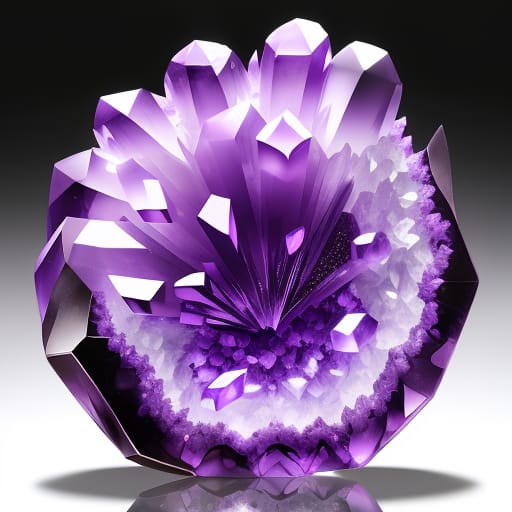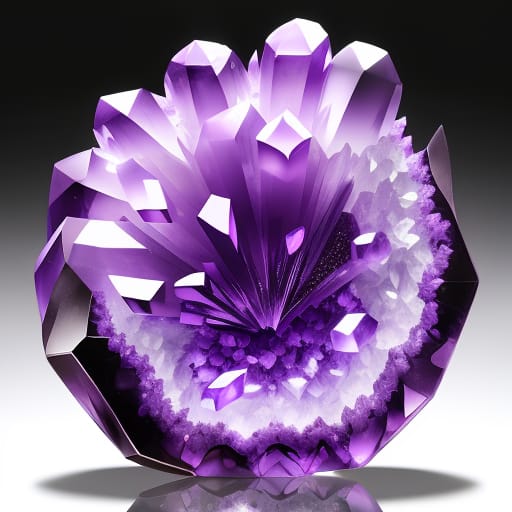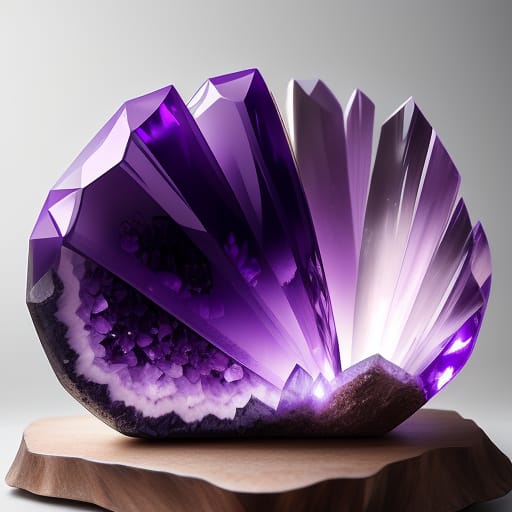Have you ever admired the brilliant purple hues of an amethyst geode or marveled at the beauty of an amethyst crystal point? These stunning gemstones have captivated people for centuries, but do amethyst crystals really form naturally?
In this beginner’s guide, we’ll explore the geology behind amethyst and explain how these quartz crystals develop their distinctive color. You’ll learn about the conditions needed for amethyst to grow in nature, where major amethyst deposits are located worldwide, and how miners extract these precious stones.
We’ll also look at man-made and synthetic amethyst created in laboratories, and compare the properties and values of natural and fabricated gemstones. Read on to uncover the science and lore surrounding one of the most popular crystals used in jewelry and healing rituals.

How Do Amethysts Form?
Amethyst belongs to the quartz family of minerals. Pure quartz is colorless, but trace elements can tint the crystals in various hues. The element responsible for amethyst’s hallmark purple coloration is iron.
Specifically, amethyst gets its color from iron impurities in the crystal structure. Iron can exist in two oxidation states – Fe^4+ (ferric iron) and Fe^3+ (ferrous iron). The specific ratio of these two oxidation states determines the color saturation. More Fe^3+ leads to deeper purple hues.<div class=”table-responsive”>
| Oxidation State | Color |
|---|---|
| Fe^4+ | Yellow/orange |
| Fe^3+ | Blue/purple |
</div>
For amethyst to form, quartz crystals must be exposed to high temperatures but limited amounts of oxygen. These unique conditions allow iron impurities to produce purple hues.
Hydrothermal Growth
In nature, amethyst often develops through hydrothermal growth in geodes and rock fractures. This involves hot, mineral-rich water flowing through cavities in lava or granite. Temperatures reaching 400-500°F allow quartz crystals to form, while the limited oxygen environment enables iron impurities to create purple hues.
As the heated water evaporates, silica accumulates on the walls of the rock cavity, causing quartz crystals to grow outward in hexagonal prisms. Trace iron is incorporated into the crystalline structure, tinting the ends of the prisms purple.
Laboratory Autoclaves
The hydrothermal process of amethyst formation can be reproduced artificially in a pressurized vessel called an autoclave. Mixed solutions of silica compounds are added along with iron salts to provide the raw materials for crystal growth.
The autoclave is heated to temperatures around 400°F to force crystal formation. Oxygen is also strictly controlled. After a period of days to weeks, lab-grown amethyst crystals are removed from the autoclave.
The Structure of Amethyst Crystals
Amethyst belongs to the trigonal crystal system. Like other quartz crystals, amethyst exhibits a hexagonal, prismatic habit. The naturally pointed terminations are a result of rapid growth along the vertical C-axis.
The basic building block of quartz and amethyst crystals is silicon dioxide (SiO2). Each silicon atom is surrounded by four oxygen atoms in a tetrahedral coordination. These tetrahedra bond together to form a continuous three-dimensional network.
Amethyst demonstrates several classic crystal forms, including the trapezohedron – a shape with 24 congruent faces. Twinning is also common, caused by mirror-image crystal growth. This can produce recognizable “chevron” or “tent” patterns inside some amethyst points.
Physical Properties of Amethyst
In addition to color, amethyst exhibits other diagnostic physical properties:
- Hardness – 7 on the Mohs hardness scale
- Cleavage – None (fracture is conchoidal)
- Streak – White
- Luster – Vitreous to glassy
- Specific Gravity – 2.6-2.7
- Refractive Index – 1.544-1.553
- Birefringence – 0.009
- Pleochroism – Weak (trichroic)
- Solubility – Insoluble in acids except HF
Amethyst demonstrates uniaxial optics with a negative optic sign. This means when viewed under crossed polarizers, the crystal does not extinct when rotated 360°.
The Rich History and Lore of Amethyst
Amethyst has been prized for thousands of years, featuring prominently in ancient myths and royalty. The word comes from the Greek “amethystos” meaning “not drunken.” Ancient Greeks believed wine drunk from amethyst goblets was protected from intoxication.
Legends say amethyst gained its color from Dionysus, the Greek god of wine. Outraged over an insult, he vowed to slay the next mortal to cross his path. Upon seeing a beautiful maiden named Amethyst on her way to pay tribute at the shrine of Artemis, Dionysus spared her life by pouring wine over her pure white quartz statue, dyeing it purple.
Amethyst was classified as a cardinal gem along with diamond, sapphire, ruby, and emerald. It was highly valued by Egyptians and was used for carving amulets. A huge amethyst geode known as the “Empress of Uruguay” was recovered in the early 1900s.
The gemstone was especially prized by royalty and the Catholic church. Amethysts have been found in British Crown Jewels and ancient Tibetan Buddha statues. Bishops traditionally wear amethyst rings.
Amethyst Crystals as a Birthstone
For modern consumers, one of amethyst’s best-known uses is as a birthstone. As the official birthstone for February, it’s a popular gem for jewelry gifts.
Amethyst is also considered a Pisces birthstone (Feb 19 – Mar 20). It’s associated with the planet Neptune and the element of water. In addition, amethyst is the 6th anniversary gemstone.
Due to its regal purple tones, amethyst has long symbolized royalty, wealth, and prestige. More recently, it has gained popularity for spiritual and healing purposes.

The Healing Properties of Amethyst
In crystal healing belief systems, amethyst is said to hold high spiritual vibrations and energy. It is associated with serenity, sobriety, and wisdom. Amethyst purportedly helps heal and activate the crown chakra at the top of the head.
Wearing amethyst or placing crystals on your body is thought by some to promote calm, balance, and connection to the Divine. Amethyst clusters are also used to “cleanse” the energy of a space.
Some say amethyst provides psychic protection against negative energy or entities. It may help relieve stress and soothe sadness or grief. Amethyst is traditionally thought to help treat addictions by providing spiritual insights. However, no scientific studies have validated the healing properties of amethyst.<div class=”table-responsive”>
| Reported Benefits | Associated Chakra |
|---|---|
| Sobriety, calm | Crown |
| Wisdom, intuition | Third eye |
| Psychic ability | Sixth (third eye) |
| Cleansing, protection | Seventh (crown) |
</div>
Where Does Natural Amethyst Come From?
For centuries, Russia was the top producer of natural amethyst crystals. Deposits in the Ural Mountains yielded abundant gemstones. However, by the late 1900s, few quality amethysts remained.
Today, major sources include:
- Brazil – Minas Gerais state
- Uruguay – Artigas region
- Zambia – Mavuzi hills
- Mexico – Veracruz, Guerrero
- Canada – Northwest Territories, Ontario
- United States – Arizona, North Carolina, and Maine
In the US, amethyst is commercially mined in South Carolina. The Ellis-Jones Mine near Due West was particularly productive, followed by the Jackson Crossroads deposit. These amethyst vugs provided beautiful crystal-lined geodes.
The Purple Heart Mine near Antreville, SC has also produced fine amethyst specimens, though it was closed in 2006. Many South Carolina sites have been depleted in recent decades.
How is Amethyst Mined?
Natural amethyst is extracted using standard hard rock mining techniques. However, unlike metals mining, gemstone mining is more selective – only the richest veins and geodes are targeted.
Tunnels are dug into hillsides where geologists have identified potential amethyst deposits. Miners follow the veins, extracting amethyst crystals along with host rock. The material is hauled to the surface for sorting.
In alluvial deposits, heavy machinery is used to remove overburden soil and excavate gravels. These are screened to collect amethyst crystals separated from host rock by weathering.
Depending on the size and shape of the cavity, geodes may be chiseled open using hand tools. When found intact, geodes make exceptionally beautiful mineral specimens. Amethyst crystals are gently removed.
What About Synthetic Amethyst?
With deposits of natural amethyst becoming depleted, synthetic amethyst has become popular. As described above, hydrothermal autoclaves allow quartz crystals to be “grown” under laboratory conditions.
Man-made amethyst has the same physical and chemical properties as natural stones, aside from origins. However, synthetic amethyst is noticeably more affordable and available in calibrated sizes and custom cuts.
The main disadvantage of synthetic over natural is value. While still technically “real” amethyst, manufactured stones do not appreciate in value like natural counterparts.
Natural amethyst has cachet as an ancient and rare gemstone. Flaws and inclusions make each stone unique. Synthetic amethyst lacks this history, story, and variability.

How to Tell Natural vs. Synthetic Amethyst
Distinguishing natural from lab-created amethyst requires expert gemological testing. Differences include:
- Inclusions – Natural stones contain tiny mineral crystals, liquids, and feathers absent in synthetic.
- Growth Lines – Synthetic amethyst shows curved striations from laboratory growth.
- Color Zoning – Natural amethyst displays uneven color gradients not seen in synthetic.
- Ultraviolet Light – Synthetic amethyst may fluoresce or phosphoresce under UV. Natural stones stay inert.
- Magnetic Response – A strong attraction to a magnet indicates synthetic amethyst.
Without advanced testing, it can be impossible to tell the difference between natural and lab-grown amethyst. Ask your jeweler for documentation of any “natural” amethysts.
Final Thoughts on Amethyst Crystals
Amethyst has been a prized semiprecious gem for thousands of years. The unique conditions required for natural growth make it relatively rare compared to other quartz crystals. While commercially mined and lab-grown stones are widely available, fine natural amethyst is increasingly hard to source.
So next time you see an amethyst cathedral, crystal cluster, or gorgeous faceted stone, consider the long natural processes required to form that brilliant purple coloration. The rarity and mystery surrounding amethyst help explain its significance across so many ancient cultures.
To learn more, explore these additional resources:
- Amethyst on Mindat.org – Comprehensive mineral data
- How Amethyst Formations Grow – Informative article
- Amethyst Galleries – Photos of natural amethyst crystals
- Amethyst: Earth’s Natural Purple Gemstone – Smithsonian overview
Let us know if you have any other questions about amethyst crystals and their natural origins!
Frequently Asked Questions
What causes the purple color in amethyst crystals?
The violet hues of amethyst quartz are produced by trace amounts of iron (Fe4+ and Fe3+) impurities in the crystalline structure. The specific ratio of iron oxidation states gives each amethyst its characteristic color saturation.
Where are the most important deposits of natural amethyst?
Historically, Russia’s Ural Mountains were the premier source of gem-quality amethyst. Today, major deposits are found in Brazil (Minas Gerais), Zambia (Mavuzi), Uruguay (Artigas), and North America (including South Carolina, Arizona, and Ontario).
How fast can amethyst crystals grow?
In nature, amethyst crystals form very slowly over millions of years. However, in laboratory autoclaves, quartz crystals can be “grown” in a matter of weeks. Controlled conditions allow rapid hydrothermal formation.
What is the largest amethyst crystal ever found?
The Guinness Book of World Records lists the “Empress of Uruguay” as the largest amethyst geode ever found. Discovered in Brazil in the early 1900s, it weighs around 2.5 tons and stands over 9 feet tall!
How can you tell natural vs. synthetic amethyst?
Distinguishing natural from lab-created amethyst requires advanced gemological testing. Only experts can detect subtle differences in inclusions, growth patterns, color zoning, ultraviolet fluorescence, and magnetic response that reveal the stone’s origins.